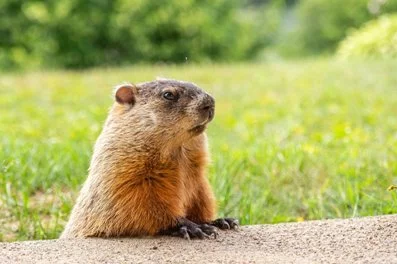- 5 Simple Tricks to Eliminate Maggots From Pet Waste - October 24, 2023
- Keep Your Outdoor Compost Piles Maggot-Free - October 24, 2023
- How to Get Rid of Maggots – Methods that Work - August 30, 2023
Groundhogs are large rodents and are members of the squirrel family and are native to North America. It is sometimes called a land beaver, ground squirrels, whistle pig. Like other burrowing rodents, they are excellent diggers that can cause severe damage to gardens. Not only do they cause devastation to vegetation, but they also damage building structures as well.
The problem is they eat any vegetation from fruits, veg, and leaves, to grass in the garden. Therefore, if you have large holes present in the yard, if you have ruled out all other possibilities, the likeliness is that you have a groundhog infestation.
So how do you get rid of groundhogs? Maybe you have read different methods of pest control using ammonia. However, before you go and call pest control services, you may want to know if this is an effective method of groundhog removal? Let us find out!
First Inspect Your Property for Groundhog Burrows
Before heading to the store and buying ammonia, you first need to inspect if it is a groundhog destroying your property. If there is damage to plants or structural damage, you will easily be able to identify the area of burrows in the yard.
First, you need to check where the groundhog is coming from and going. You will find the whistlepig holes hidden under stones, sticks, or leaves.
You need to look for tunnels about 12 inches in circumference or sinking foundations, causing damage to the plants in the garden.
How to use the ammonia
Groundhogs hate ammonia and to some extent, it does work to remove them from your property. However, it helps if you got the Cloudy or Sudsy Ammonia for it to work effectively.
The fantastic thing is you can buy it from the local store and make a repellent at home. You need to mix two tablespoons of the cleaner in a ¼ cup of water. Now add two cups of the ammonia to the solution and make sure to stir it well. For it to work effectively, you need to pour the solution down the burrows.
You need to make sure when you pour ammonia solution in the goundhog hole, that you use enough to be effective. Furthermore, you need to keep checking the burrows and repeat the process daily until all of them are gone.
Use ammonia soaked rags
One of the most effective ways is to soak some old rags in ammonia and place them around your property. Please do not do this if young children or household pets use your garden, as ammonia is a toxic substance and can cause irritation to eyes and lungs.
Mothballs
A popular ammonia product to use is mothballs to drive the groundhogs away. Another method is to use simulated fox urine as it also forces them elsewhere. The problem with using ammonia as a repellent is that it only drives them away to start digging further in another part of the field or garden. On the other hand, groundhogs are intelligent and will leave several entrances to escape.
Before using the repellent, or any other method described here, please check with the laws of your state as killing groundhogs in some regions is illegal. If the problems gets out of control you may be left with few other options, but it is better to keep them out of your property rather than having to resort to kill groundhogs.

What should you do if the ammonia doesn’t deter the groundhogs?
While ammonia is effective in removing groundhogs to some extent, it may not always work. Therefore, you still need to use other means of eliminating the woodchucks. Here are some different great ways to make sure your yard is groundhog free:
You can get rid of their food source
By removing the possible food source will leave the groundhog starving, forcing them to move to a new destination. However, sometimes this not an easy task as the groundhog eats anything. You can remove fruit falling on the ground daily. Furthermore, make sure you have a tightly sealed trashcan and keep it in a secured area, not within reach.
Plug up the Holes
You can find up to six different openings to the groundhog’s burrow. A great way to prevent them from exiting the holes is to plug up each hole with cement and leave only one open for them to escape. Sometimes it can be useful while other times it is not as who wants concrete patches all over the garden.
Groundhog Trap – the best method
An excellent method is to use traps, but before using one, make sure it is legal in the region. We recommend using a humane homemade groundhog trap to capture and release. There are different traps available you can use from one that catches the pest one at a time or using one that catches two or more at the same time.
At first, you may not notice instant results, as they prefer vegetation from the garden instead of the bait in the trap. The best way is to make guide logs with a path leading to the cage.
If you are not up to it, you can always call in an expert to remove and release the woodchucks for you. The reason for doing this is that the animal can become aggressive when trapped. Therefore, you need to take caution not to be injured in the process.
Other Effective Groundhog Repellents
While the above repellents are the most effective way to deter groundhogs, you can find other means of deterring them as well:
- Nature’s Defense Repellent – the organic deterrent is organic and drives groundhogs away wherever applied. The repellent has an off-putting taste and scent. The product is easy to use in a granule form to spread by hand near the holes of the burrow. You can even place it around crops or the land you want to protect. This is preferable than using poison for groundhogs which for some people is ethically questionable and can also harm the environment.
- Ammonia Cocktail – here, you can mix the ammonia with vinegar, washing detergent, and hot pepper to pour down each hole. However, it helps to remember that the repellent is dangerous and you should not use groundhog poisons around pets or children.
- Ammonia as Bait – another effective way is to place a cage near the hole and covers it with mud to leave it undetected by the hog. You can lure the animal with veg or fruit on the inside of the trap. Once you set up the trap, you can pour the ammonia on the inside of the hole to drive them out into the cage.
- Ammonia or Bleach Spray – here you need to determine the fence perimeter to prevent the rodent from digging underneath it. Make a mixture of the ammonia and spray it around the fence from where you see the hogs coming in. You will need to repeat the process as it can be washed off with rain or wetting the garden. Ammonia spray for maggots is another common use of this chemical.
- Cat Urine – Empying the contents of a used cat litter tray on groundhog holes can also be a good deterrent as urine contains ammonia and cat waste has a very pungent smell.
- Vinegar – some people believe that vinegar can be a good groundhog deterrent
Final Thoughts
These are some practical ways to rid your garden from a groundhog problem. However, it helps if you remembered the pest is destructive once it is on the property. The safest method of groundhog control is with Nature’s Defense that is a natural repellent to trap them.
Another effective way is to call in a professional to remove the woodchucks from your place. There are many ways to prevent them from getting access to your home by taking precautions, not just for groundhogs, but for other critters too such as getting rid of chipmunks and squirrels.
We hope that you find a humane way to keeping groundhogs away, and maintaining your garden and property in tip-top shape.
